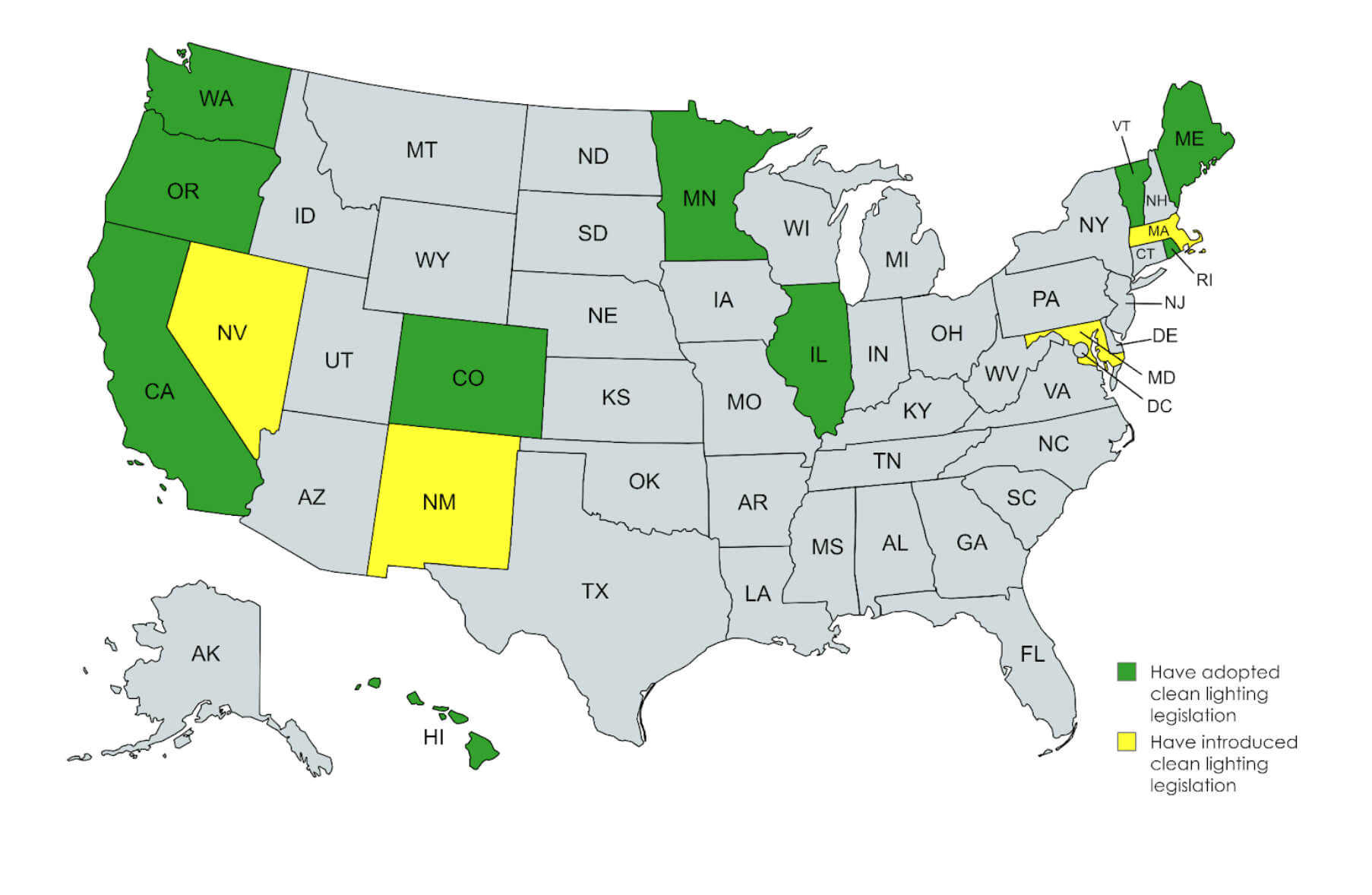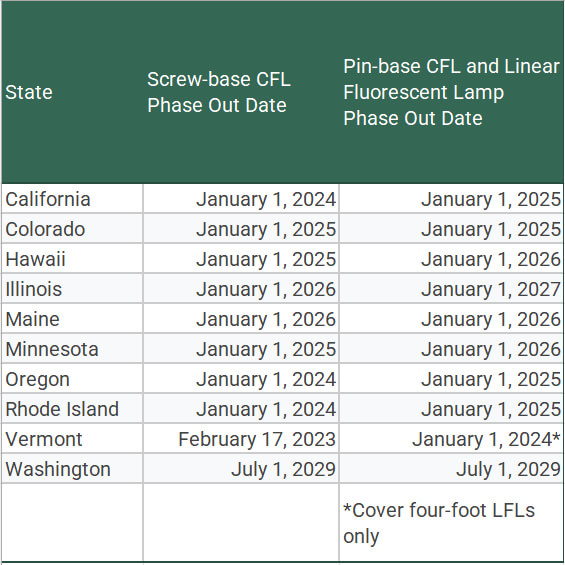Clean lighting
Shining a light on clean lighting standards.
Fluorescent lights are a common sight in offices, garages, and basements—but they contain toxic mercury and use far more energy than newer alternatives. By phasing out fluorescents in favor of efficient LED bulbs, states can avert a needless health risk, save families and business money on utility bills, and curb greenhouse gas emissions.
Flipping the Switch to Clean Lighting
Ten states have phased out the sale of most fluorescent light bulbs in favor of LEDs, generating significant energy, carbon dioxide, and utility bill savings while avoiding a source of mercury pollution. Interested in doing the same for your state? See below for resources.
Fluorescent lights are a common sight in offices, garages, and basements—but they contain toxic mercury and use far more energy than newer alternatives. By phasing out fluorescents in favor of efficient LED bulbs, states can avert a needless health risk, save families and business money on utility bills, and curb greenhouse gas emissions.
Fluorescent lighting was once the preferred option for many uses, but not anymore. LED light bulbs—readily available as replacements for fluorescents in all needed shapes and sizes—do not contain any of the toxic mercury that fluorescent bulbs do. They also cut energy use in half compared to fluorescents, last about twice as long, and typically cost far less to purchase and operate over their lifetime. So why are fluorescents still on store shelves?
In 2022, Vermont and California became the first states to phase out the sale of most fluorescent bulbs. In 2023, Hawaii, Oregon, Colorado, Maine, and Rhode Island adopted similar policies. In 2024, Washington, Minnesota, and Illinois became the eighth, ninth, and tenth states to adopt clean lighting legislation. As more states move to eliminate fluorescents, states without a clean lighting policy risk becoming a dumping ground for inefficient, mercury-containing bulbs that suppliers cannot sell elsewhere.
Clean Lighting Advocacy Toolkit
Informational Resources
| If you'd like information about... | Go to... |
| Savings for your state | Potential state savings from 2026 clean lighting policies |
| 2026 clean lighting model bill | 2026 clean lighting model bill (Word document) |
| The lighting market | "Farewell to Fluorescent Lighting: How a Phaseout Can Cut Mercury Pollution, Protect the Climate, and Save Money." |
| The human health impact of fluorescent lighting | "Mercury in Fluorescent Lighting: Unnecessary Health Risks & Actionable Solutions" |
| National clean lighting webinar | Clean Lighting: How States Can Cut Mercury Pollution, Protect the Climate, and Reduce Utility Bills |
Advocacy Example Material
|
Advocacy Material |
Example Document |
|
Sign-On Letter |
Sign On for AB 2208, Mercury Lamp Prevention Pollution Act |
|
Frequently Asked Questions (FAQ) |
Clean Lighting FAQ |
|
Press Release |
New law Moves Maine toward lower-cost mercury-free light bulbs |
|
Written Committee Testimony |
Maine - Clean Lighting House Energy Committee Written Testimony |
|
Op-Ed |
Choice is Simple, Time to do Away with Fluorescent Bulbs |
|
State Fact Sheet (2023) |
Maine Clean Lighting Fact Sheet |
|
Email Action Alert |
Draft Email Action Alert |
|
Organized Labor Fact Sheet |
Labor Fact Sheet |
Reduce the Threat of Mercury Exposure
All fluorescent bulbs contain mercury, a potent neurotoxin that threatens human health and the environment. The World Health Organization counts mercury among the top 10 most dangerous chemicals impacting public health.
 When fluorescent bulbs are accidentally broken—whether in homes, businesses, or the waste management system—they present a health hazard to those nearby. And when fluorescent bulbs are not disposed of properly—as happens with an estimated 75% of bulbs—mercury leaches from landfills and eventually contaminates rivers, lakes, and oceans and the fish and shellfish within them.
When fluorescent bulbs are accidentally broken—whether in homes, businesses, or the waste management system—they present a health hazard to those nearby. And when fluorescent bulbs are not disposed of properly—as happens with an estimated 75% of bulbs—mercury leaches from landfills and eventually contaminates rivers, lakes, and oceans and the fish and shellfish within them.
LEDs, which are mercury-free, are a much safer option. Technological advancements in recent years have made them readily available and cost effective.
Save Money on Electric Bills
Fluorescent bulbs are no longer the most affordable lighting option. Because they are more energy efficient than fluorescents, LEDs cost less to operate, more than paying back their slightly higher upfront costs—which continue to drop each year—through lower electric bills. A typical school could see more than $3,700 in annual utility bill savings if all its fluorescent bulbs were replaced with LEDs.
LEDs also last about twice as long as fluorescents, so they need to be replaced less often. And because LEDs do not contain mercury, a hazardous waste, they can be disposed of more easily and cheaply than fluorescents when the time comes.
Avoid Needless Greenhouse Gas Emissions
 LEDs use approximately half the electricity as fluorescent bulbs to produce the same amount of light. As a result, accelerating the transition to LEDs can reduce planet-warming emissions from power plants and help prevent the worst effects of climate change.
LEDs use approximately half the electricity as fluorescent bulbs to produce the same amount of light. As a result, accelerating the transition to LEDs can reduce planet-warming emissions from power plants and help prevent the worst effects of climate change.
States that have passed clean lighting legislation will avoid the release of 14.5 million metric tons of carbon dioxide, the equivalent of the emissions of 3.4 million gasoline powered vehicles driven for one year.
States have the chance to act now and join the growing movement to phase out the sale of fluorescent light bulbs in favor of LEDs. See the resources below for materials to help your state.